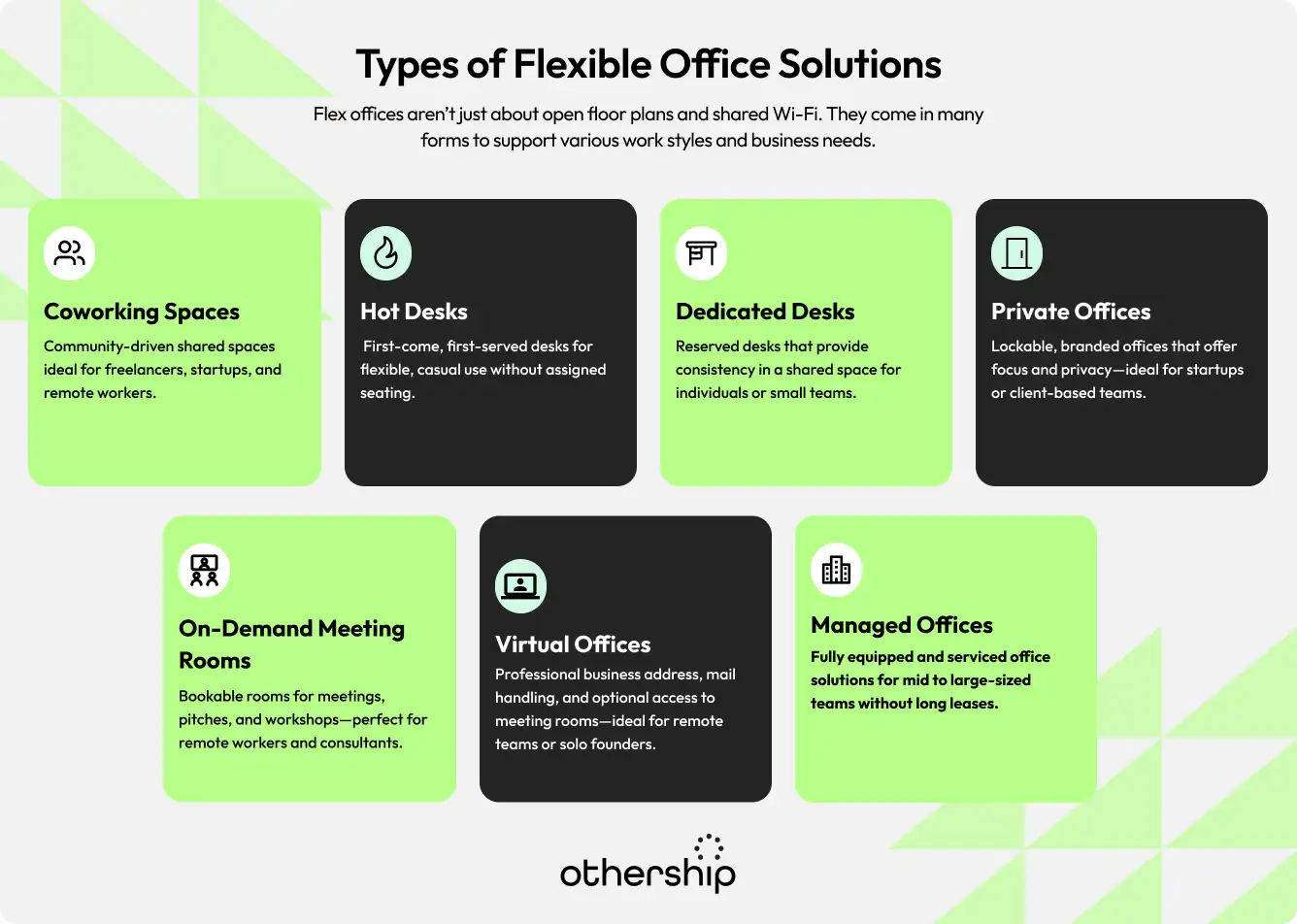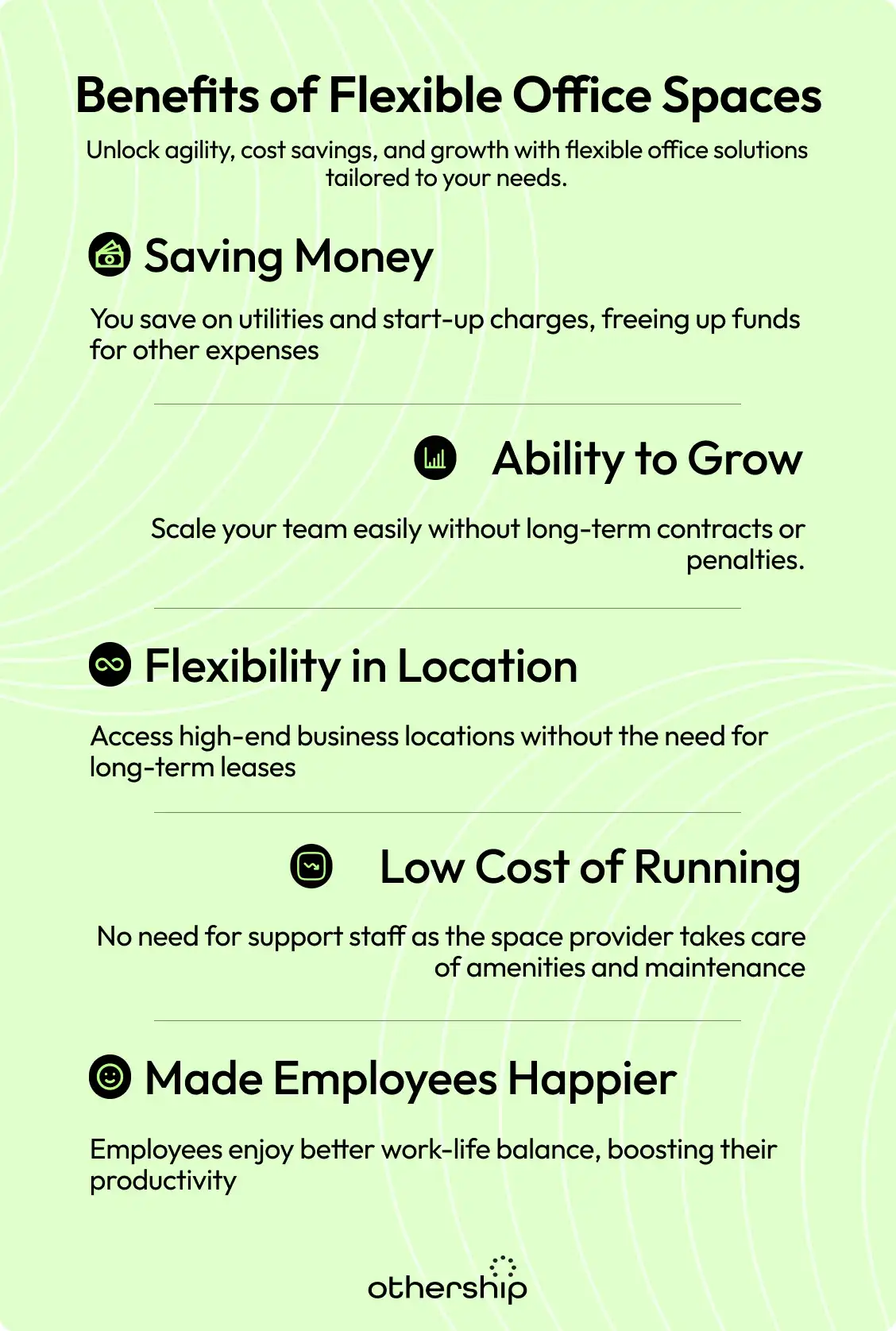In today’s fast-paced corporate world, being able to change quickly is highly important, especially when it comes to where and how we work. That’s where “flexible office space” or “flex office” comes in.
A flexible office space is a modern workspace solution designed for businesses that need freedom from long-term leases, rigid layouts, and one-size-fits-all office setups.
It has alternatives for short-term rentals, shared facilities, and the opportunity to scale up or down as your team’s needs change. Think coworking spaces, serviced offices, or hybrid-ready hubs designed to work the way you work.
The demand for flexible offices has increased as more people launch their businesses, work from home, and employ hybrid models. Start-ups require room to expand. HR departments are revaluating how they manage workspaces.
Freelancers want structure without having to pay for it. Real estate decision-makers are searching for more economical and adaptable options. Flex offices check all those boxes.
In this guide, we’ll break down everything you need to know, from the types of flexible workspaces available to the benefits they offer and how to choose the appropriate setup for your business. Whether you’re scaling fast or simply rethinking your office strategy, you’re in the right place.
Contents
Types of Flexible Workspaces
Flex offices aren’t just about open floor plans and shared Wi-Fi. There are a lot of choices that work for teams of all sizes, work settings, and company needs.

Here is a list of the most frequent types of flexible workplaces and how each one might help you do your job.
-
Coworking Spaces
Coworking spaces are shared, community-driven workspaces that are ideal for freelancers, start-ups, and remote workers who value networking and collaboration with others.
-
Hot Desks
Hot desking allows you to use any available desk on a first-come, first-served basis—no assigned seating. It’s great for professionals who don’t require their own office every day but want to be able to work in a professional setting from time to time.
-
Dedicated Desks
Unlike hot desks, Dedicated desks are yours and exclusively yours. You can leave your things on your desk in a shared space. Great for individuals or small groups who want to maintain consistency without needing an office.
-
Private Offices
Private offices offer the privacy and focus of a traditional workspace, with the flexibility to rent them for short or long periods. They provide a secure, professional environment—often located within coworking spaces or flexible office centers—making them ideal for growing startups, client-focused teams, or individuals who value a quiet, dedicated space.
-
Managed Offices
A managed office is a complete solution that comes with everything you need. You can get fully serviced offices geared to your business without setting them up or signing a long lease. Great for teams of mid to large size.
-
Virtual Offices
Want to run a business without having a desk? A virtual office gives you a professional address, handles your mail, and occasionally gives you access to meeting spaces. This is great for firms that work from home or for solitary entrepreneurs.
-
On-Demand Meeting Rooms
Sometimes, you only need a room for a quick meeting, pitch, or workshop. You can book it by the hour or the day for meetings, pitches, or seminars. Great for people who work from home, sales teams, or consultants who work from home and sometimes need to meet in person.
Key Features of Flexible Office Spaces
If you set up your workstation correctly, it can be more than just a place to work; it can be a place to grow. Here are the five key features that make flexible office spaces such a practical, future-ready solution:
-
Flexible Leasing Options
One of the best things about flex offices is that they are flexible. You don’t have to make long-term commitments; you can rent by the hour, day, or month, paying only for what you use.
Shared amenities, like high-speed Wi-Fi and well-stocked coffee machines, are always included. Most flex spaces also give you access to conference rooms, printers, lounges, and other amenities that are kept up for you. In short, you get everything you need to do your job well, and you don’t have to worry about managing it yourself.
-
Scalable Options for Growing Teams
Your office can expand with your business as it does. Flex office providers make it simple to improve your space, whether adding a few desks or moving into a private office. You don’t have to move buildings or renegotiate long-term leases every time your staff grows.
-
Tech-ready and plug-and-play infrastructure
Time is cash. You may immediately move into flexible office spaces because they are tech-ready and completely furnished. All you need is your laptop. In a nutshell, you don’t have to wait for it to work or set it up; you can start working right away.
-
Vibrant Community and Networking Opportunities
Many flex offices double as professional communities that hold events, workshops, and chances to network more casually. The community is a valuable bonus if you’re looking to build partnerships, find clients, or connect with like-minded professionals. It’s great for freelancers, startups, and anyone who works from home who wants to meet new people and stay inspired.
Benefits of Flexible Office Spaces
Flexible office spaces are becoming the go-to choice for businesses looking to stay agile and cost-effective. These spaces offer a level of freedom and convenience that traditional offices just can’t match, helping companies adapt to growth and change without the hassle of long-term commitments. Plus, they provide employees with a better work-life balance, ultimately boosting productivity.

Here’s why more and more businesses are making the switch to flexible office spaces:
-
Saving money
You don’t have to pay for utilities or start-up charges with flex offices. Instead, you can put that money toward other expenses.
-
Ability to grow
Is your team expanding faster than you thought? With a flex office, you can easily scale up or down your team without signing extended contracts or paying penalties.
-
Flexibility in location
Want a high-end business location in the middle of the city without signing a long-term lease? Many flexible office providers offer professional areas without signing long-term contracts or paying a lot of rent.
-
Made employees happier
Flex offices help and support better personal and professional lives which could boost productivity.
-
Low cost of running
You don’t have to recruit support workers because flex workspace takes care of the amenities, tech, and maintenance for you.
Flexible Office Space vs. Traditional Office
Depending on an organization’s size, stage of growth, and operational needs, both flex offices and traditional offices have pros and cons. Below is a comparison of the two models based on essential criteria.
|
Criteria |
Flexible Office Space |
Traditional Office |
| Lease Terms | Short-term (month-to-month or 6–12 months) | Long-term (typically 3–10 years) |
| Upfront Cost | Low (minimal deposits, furniture & utilities often included) | High (security deposit, fit-out, furniture, IT setup) |
| Move-in/Setup Time | Fast (often ready within days) | Slow (can take weeks or months for setup and customization) |
| Flexibility | High (easy to scale up/down or relocate) | Low (locked into lease, hard to scale or exit early) |
| Operational Complexity | Low (managed services included: cleaning, internet, security) | High (tenant manages facilities, IT, maintenance, etc.) |
Flex offices have become a practical solution since they provide the correct space when and where needed, without requiring long-term commitments.
Here’s a look at who is embracing flexible workplaces and why they are making the switch:
- Startups with unpredictable growth
Flex offices are great for businesses that need to quickly modify their team size or funding because they don’t have to sign long-term leases or pay a lot of money.
- Remote teams need part-time meeting space
You can book conference rooms or day offices as needed for in-person meetings without renting a full-time office.
- Freelancers looking for a professional setup
Freelancers and independent contractors can get a productive, well-equipped workspace without committing to it for a long time. This is great for networking and staying focused.
- Corporations creating satellite or client-facing offices
Big organizations typically use flexible offices to expand into new regions as satellite offices or client-facing hubs. These locations are a quick and low-risk method to set up shop in new towns or areas. They give teams everything they need to run their business well from the start, such as reception services, conference rooms, and help with local businesses.
- International teams setting up temporary workstations
When multinational teams go on business trips, attend conferences, or meet with clients, they require trustworthy spaces and have everything they need. Flexible offices have short-term workstations that let teams stay productive without dealing with complicated local leases or infrastructure. It’s a good choice for global flexibility and smooth operations.
How to Pick the Best Flexible Office Space
Not all workstations are the same. The most important thing is to pick one that meets your team’s demands without sacrificing comfort, convenience, or affordability.
Use this helpful checklist to help you find the best flexible office space:
-
Location and Commute
Pick a place to work that is convenient to get to, close to public transportation, parking, and other local services. For teams that work with clients, choose a professional, easy-to-reach place.
-
Workspace type that fits their use case
Different arrangements are needed for different needs. Choose the right location for your needs: hot desks for freelancers, private offices for small teams, and conference rooms for when you need to meet in person.
-
Community and Culture
The mood is essential. Would you rather work in a calm, professional space? Or one that is fun and works together? Find a vibe that works for you, whether quiet and concentrated or social and collaborative. A vibrant community can help you make meaningful connections.
-
Amenities offered
Modern offices should include more than desks. Look for fast Wi-Fi, electronics for conference rooms, climate control, and access to the kitchen. A room with all the right tools makes people more productive. Make sure the amenities are complete.
-
Pricing Transparency
Stay away from extra costs. Make sure that the charges for workstations, conference rooms, and extras are clear and based on use. Reliable platforms and providers will be open about prices from the outset.
-
Flexibility in lease/usage terms
The best thing about flexible workspaces is that they are flexible. Can you make a reservation for an hour, a day, or a month? How long do you have to give notice before you may cancel or pause your subscription? If your staff grows, is adding desks or relocating to a bigger space straightforward? Short-term commitments and possibilities that can grow are best for job cycles that aren’t always the same.
-
Reviews and platform trustworthiness
Do some research before you sign up and look at reviews from people who have used it before and are using it now. Find out how long the platform has been around and what others think about it. Does it listen to what you say? Look at pictures and take virtual tours to understand the space. Don’t only trust flashy ads; user reviews often give a more accurate picture.
Top Flexible Workspace Platforms and Providers
More and more individuals are working from home, which is making businesses rethink how they use office space. Long leases, headquarters that aren’t used enough, and arrangements that aren’t always the same don’t work anymore.
However, Othership is one of the best flexible workspace platforms that lets you manage where and how your teams work more flexibly.
Othership isn’t just about acquiring a desk. It’s also about offering your employees alternatives and freedom, whether you’re a start-up trying out new markets or a large organization working on your real estate strategy. With their Enterprise service, businesses may access more than 700 checked workplaces in the UK and worldwide. The Othership directory ensures that your team can get things done, no matter where they are.
Find Your Perfect Workspace Today
Browse hundreds of flexible workspaces tailored to your needs—coworking spaces, private offices, meeting rooms, and more.
Future Trends in Flexible Office Space
As we look to the future, a few important themes are affecting the design of flexible workspaces. Here’s what to expect and why it’s essential for businesses of all sizes.
- Increasing demand from hybrid teams
Hybrid work isn’t just a fad; it’s becoming the standard way of doing things for a lot of businesses. Because of this, more and more firms are moving away from having a fixed headquarters and using on-demand, distributed workspaces instead.
2. Integration with booking software and team member experience platforms
Businesses are putting money into platforms that handle desk and meeting room reservations and keep track of how many people use them, how much they cost, and how happy employees are. This trend helps businesses run more smoothly and ensures that employees have the proper area at the right time, with little work on the part of the admin.
- More focus on sustainability, mental health, and well-being
People who work nowadays want more than simply desks and Wi-Fi. We’re seeing a change toward buildings that are good for the environment and use less energy. Wellness facilities on site include meditation rooms, standing desks, and ergonomic furniture. Workspaces are becoming a part of the company’s culture, which is good for employees and the environment at the same time.
- Growth of suburban and regional coworking hubs
City workplaces are becoming less relevant as more and more individuals work from home or in a mix of home and office. Because of this, there is increasing demand in suburban, regional, and even rural areas. This is important because people want to find better jobs closer to home.
Conclusion
Now is the right moment to consider how flexible workspaces can fit into your long-term plans, as these trends will continue to change.
Need some desks this month and a whole floor next quarter? Not an issue. You can grow or shrink your workforce in a flexible office space. Get your utilities, maintenance, cleaning, and even coffee in one monthly charge to save money on overhead. That means less paperwork, fewer bills, and greater peace of mind. Are you ready to see the benefits?




You must be logged in to post a comment.